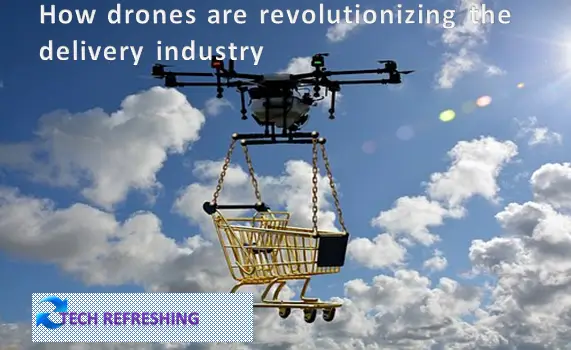Drones also known as unmanned aerial vehicles (UAVs), are aircraft that can be controlled remotely or fly autonomously using onboard computers and sensors. They have gained popularity in recent years due to advancements in technology, making them accessible for both commercial and consumer use. Drones come in a variety of sizes, shapes and designs, ranging from small consumer drones that can fit in the palm of a hand to large commercial drones used for industrial applications.
In simple terms a drone consists of a body, propellers, a battery and a control system that includes a computer and sensors. The computer and sensors are used to control the flight path, stabilize the drone and collect data. Some drones are equipped with cameras, making them useful for aerial photography and videography. They can also be equipped with other payloads such as sensors, lasers, delivery packages or depending on the intended use.
Drones can be used for a variety of tasks such as delivery services, agricultural, surveying, search and rescue missions, and military and law enforcement activities. They have transformed numerous sectors by offering a fresh and effective approach to carry out operations that were traditionally handled by people or ground-based vehicles. Drones are expected to play a significant role in a variety of businesses in the years to come because to their adaptability and rising accessibility.
Brief history of Drone Technology
The idea of using drones dates back to the early 1900s, but it was not until recent times that advancements in technology allowed for their practical application. Initially, drones were utilized mainly for military purposes and the US military started using them for reconnaissance and bombing operations in the year 1960.
Drone technology started to advance in the early 2000s, moving from military to commercial and consumer uses. This resulted from technological developments including component shrinking, higher computing power and sensor breakthroughs. Drones became less expensive as a result, increasing their affordability for both consumers and enterprises.
The introduction of small, affordable drones for personal usage in the 2010s helped the commercial drone industry take off. These drones were equipped with cameras, allowing aerial photography and videography to be done with them. Drones are becoming more and more popular for these uses, which drove more technological development and enhanced their sophistication and capabilities.
Drones have found application in a range of contemporary operations such as delivery services, agriculture, surveying, search and rescue missions, and military and law enforcement activities. They have also made their way into industries like mining, energy, and construction.
The purpose of the blog post is to provide an overview of the role and advantages that drones are playing in revolutionizing the delivery industry.
Advantages of Drones in Delivery Industry:
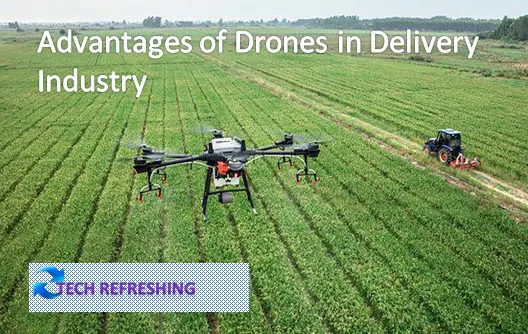
Speed and Efficiency:
Drones have a considerable edge in terms of delivery effectiveness and speed. Their ability to fly directly to the destination and avoid traffic speeds up delivery times and increases client satisfaction. They are perfect for delivering goods across great distances since they can travel farther in less time than ground-based vehicles. Drone use also results in fewer delivery cars on the road which reduces pollution and traffic.
Cost-Effectiveness:
Compared to conventional delivery techniques drones can also be more affordable, particularly for distant or challenging-to-reach sites. Through delivery process automation, they can also lower labour costs. As a result, there will be less need for delivery employees who can then be assigned to other jobs, making the delivery process more streamlined and effective. Since drones are powered by electricity rather than gasoline, they can also save money on fuel. Drone technology is also becoming more accessible and inexpensive for delivery companies because of falling costs.
Improved Safety:
Drones enhance safety in the delivery industry by reducing the need for delivery drivers and minimizing the risk of accidents and injuries. They are especially useful in hazardous environments where traditional delivery methods may not be practical. For instance, they can deliver medical supplies in disaster zones, keeping delivery personnel out of harm’s way. Equipped with sensors and onboard computers, drones can detect obstacles and adjust their flight path and reducing the risk of collisions.
Flexibility and Accessibility:
Drones provide increased versatility and accessibility in the delivery sector by being able to operate in various locations, including remote or challenging areas. This expands the reach of delivery services and provides access to goods and services in previously underserved regions. With the ability to schedule deliveries for specific times, drones are ideal for delivering perishable items or when customers are not available. Drones can handle last-mile delivery, minimizing the use of ground vehicles and simplifying the process for customers to receive their packages.
How Drones are Being Used in Delivery Industry:
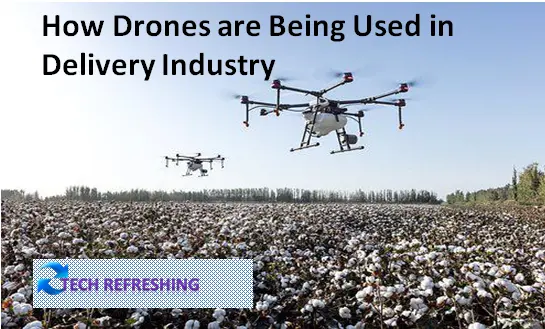
Package Delivery:
Increasingly businesses are using drones to deliver packages. They provide a reliable alternative to using ground transportation for the delivery of small parcels and papers. Drones can enable multi-delivery flights, which optimises delivery routes and lowers fuel costs.
Medical Delivery:
Drones are also being used in the medical delivery industry where they are being used to deliver critical medical supplies and equipment to remote or hard-to-reach areas. For example, they are being used to deliver life-saving medicines, vaccines and other medical supplies to remote villages and disaster zones, where traditional delivery methods may not be feasible.
Food Delivery:
The use of drones in the food delivery sector is becoming increasingly popular as they offer faster and more efficient service. With the ability to directly deliver hot meals and snacks to customers, drone delivery ensures that food arrives fresh and hot. Drones can reach remote areas providing better access to food in previously underserved locations and reducing the need for ground-based delivery vehicles.
Agricultural Delivery:
Drones are playing a role in agriculture where they are utilized for tasks such as crop spraying, soil analysis and monitoring. Drones are efficient for crop production as they reduce manual labor in tasks like pesticide spraying. With the ability to monitor crop health, soil moisture and other key aspects, drones assist farmers in making informed decisions.
Challenges and Limitations of Drone Delivery:
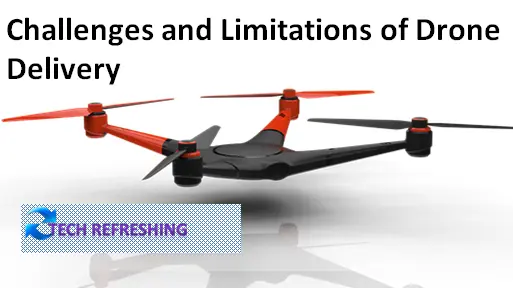
Technical Challenges:
The difficulties in controlling drones technically are one of the biggest obstacles to drone delivery. Advanced technology is needed for drones, including costly and challenging to maintain sensors, cameras and navigation systems. Drones can be impacted by weather conditions including wind, rain and snow, which can delay flights and have an effect on both the drone’s safety and delivery.
Regulatory Challenges:
Regulatory challenges pose a hindrance to the growth of drone delivery. Governments impose strict regulations on drone usage, limiting the operational capabilities of delivery companies. For instance, restrictions on flight paths and designated flying zones narrow down delivery areas. Adherence to safety and privacy regulations also increase the cost and complexity of drone delivery operations.
Privacy and Security Concerns:
Concerns about privacy and security are another obstacle to drone delivery because these devices have cameras and other sensors that might gather sensitive data. Drones run the potential of being used maliciously, jeopardising the privacy and security of people and organisations through espionage or theft. Furthermore, there is a chance that drones could be compromised and utilised maliciously, which could lead to significant security breaches.
Cost of Implementation:
Cost is a hindrance to widespread adoption of drone delivery by delivery companies. Drones come with a high price tag for purchase, upkeep and operation, which can present challenges for smaller delivery companies. Moreover, the need for additional infrastructure, such as charging stations and maintenance centers, raises the cost of implementing drone delivery. Training personnel and implementing new processes also bring additional costs that may affect the profitability of drone delivery.
The Future of Drone Delivery:
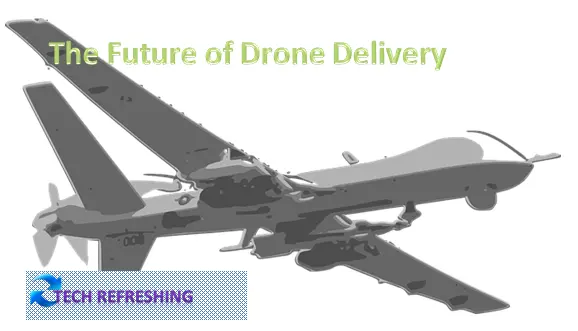
The outlook for drone delivery is positive as technology advancements and changes in regulations make it more possible and accessible. The near future is likely to bring an increase in drone delivery firms and improvement in drone capabilities and range.
The introduction of autonomous drones, which do not require human pilots and hence reduce operating costs while boosting delivery speed and efficiency, is one trend that is likely to emerge. Drones will be utilised in conjunction with ground-based delivery vehicles in a second trend that will see them integrated into the current distribution network, expanding the flexibility and reach of delivery services.
Drones will be able to fly farther thanks to improvements in battery technology and charging infrastructure, expanding the range of delivery services and enabling the transportation of goods to remote locations. Finally, legislative adjustments will lower entry barriers and increase competition in the drone delivery business by making it simpler for delivery companies to use drones.
There will soon be exciting developments in drone delivery. Due to the many advantages drone delivery offers, including speed, efficiency and affordability, this business is positioned for sustained growth and innovation in the years to come. The delivery sector could undergo a major transformation because to drone delivery.
Predictions and Projections for Drone Delivery:
- Increased Adoption: As the technology becomes more widely available and affordable, it is expected that drone delivery will continue to gain popularity in the years to come.
- Expansion of Delivery Range: It is projected that drone delivery will grow in scope, enabling the delivery of goods to isolated and rural areas that are currently unreachable by traditional delivery methods.
- Increased Autonomy: It is anticipated that the usage of autonomous drones will grow, reducing the need for human pilots and boosting delivery efficiency and speed.
- Integration with Ground Delivery: It is anticipated that ground-based delivery vehicles would be combined with drone delivery, expanding the reach and adaptability of delivery services.
- Improved Battery Technology: As batteries get more advanced, drones will be able to fly farther, expanding the selection of delivery services.
- Regulatory Improvements: It is anticipated that regulatory changes will make it simpler for delivery companies to use drones, lowering entry barriers and boosting competitiveness in the drone delivery market.
- Market for Drone Delivery Growth: As more businesses enter the market and demand for drone delivery services rises, market growth for drone delivery services is anticipated.
Overall, the future of drone delivery is bright and it is expected to have a significant impact on the delivery industry in the coming years. The benefits of drone delivery including speed, efficiency and cost-effectiveness, make it a promising technology that has the potential to revolutionize the way goods are delivered.
Advancements in Drone Technology:
- Improved Flight Performance: Longer flight times, larger payload capacities and improved stability and manoeuvrability are just a few of the improvements in flight performance that have been made possible by advances in drone technology.
- Grown Autonomy: As autonomous drones are developed, drone delivery efficiency and security have increased. This is because drones can now be programmed to fly specified routes without the need for human participation.
- Advanced Sensing and Navigation: Drones are now able to safely navigate around obstacles and make exact deliveries thanks to the integration of advanced sensing and navigation technology.
- Improved Battery Technology: Drones can now fly farther thanks to advancements in battery technology, expanding the range of delivery services.
- Increased Data Management: Big data and cloud computing integration have made it possible for drones to collect and manage massive amounts of data, enhancing the effectiveness and precision of delivery services.
- Development of Dedicated Charging Infrastructure: By enabling drones to be quickly recharged, dedicated charging infrastructure has decreased downtime and improved the speed and efficiency of delivery services.
Drone delivery is now a feasible and affordable option for the delivery of goods thanks to these developments in drone technology. The capabilities and effectiveness of drone delivery services will significantly improve with the continuing development and integration of new technology.
Integration with Other Technologies:
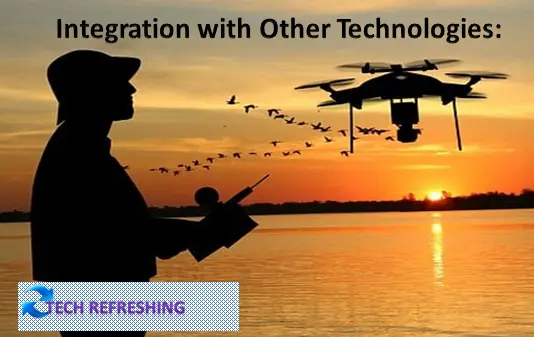
- Artificial Intelligence (AI): Artificial intelligence (AI) is being integrated with drone technology to give drones the ability to make decisions in the moment and adapt to changing circumstances. As a result, drone deliveries will be more effective and secure since they will be able to make judgements based on real-time data and adjust to changing circumstances.
- Internet of Things (IoT): By combining drones and IoT technology, delivery services will be more transparent and reliable as delivery progress can be tracked and monitored in real-time.
- Blockchain: By combining drones and blockchain technology, delivery transactions will be more secure and transparent, allowing for real-time tracking of the flow of goods.
- Virtual and Augmented Reality (VR/AR): The use of drones combined with VR/AR technology will allow for virtual delivery experiences, giving customers a more immersive experience and increasing delivery process transparency.
- 5G Networks: Drones will be able to communicate more quickly and reliably thanks to the integration of 5G networks, allowing for real-time data transfer and quick responses from drones to changing environmental conditions.
The delivery sector will greatly benefit from these technological linkages, allowing for an increase in delivery services’ dependability, efficiency and speed. Deliveries using drones will become much more efficient as new technologies are continuously incorporated, which will also completely alter how goods are delivered.
Potential Impacts on Society and the Environment:
- Economic Impact: By expanding job opportunities and bringing down delivery costs, drone delivery has the potential to have a big impact on the economy. It might also make it easier for those in isolated or underserved locations to access goods and services.
- Improved Accessibility: Drone delivery has the potential to improve access to goods and services, particularly in rural or underserved areas, enhancing the standard of living for residents of these places.
- Environmental Impact: Since drones are cleaner and more fuel-efficient than traditional delivery vehicles, they have the potential to significantly reduce the carbon footprint associated with conventional delivery methods.
- Safety: Drone delivery has the potential to increase safety by lowering the number of traffic accidents linked to conventional delivery techniques and lowering the risk of theft or damage to goods while in transit.
- Privacy Issues: Since drones may be used to gather information and monitor people without their permission, drone delivery may give rise to privacy issues. Through laws and policies that safeguard people’s privacy, it is crucial to address these issues.
- Impact on Traditional Delivery Methods: The use of drones for delivery has the potential to replace conventional delivery services like ground-based delivery, which could result in employment losses in these sectors.
Drone delivery holds the potential to significantly affect both society and the environment. It is crucial to thoughtfully examine these impacts and establish regulations and guidelines to maximize the benefits of drone delivery while mitigating any negative impacts.”
Conclusion:
Drones have the potential to revolutionize the delivery industry by offering quicker, more effective and more economical delivery services. With industries such as package and medical delivery already embracing technology, the use of drones for delivery has seen significant expansion.
Other important obstacles that must be overcome include technological difficulties, legal difficulties, privacy and security issues, and the expense of implementation. Despite these difficulties, drone delivery has a promising future thanks to ongoing drone technological developments and integration with other technologies like AI, IoT, blockchain, VR/AR, and 5G networks.
The impact of drone delivery on society and the environment will also be significant and it is important to carefully consider these impacts and develop regulations and guidelines that ensure that the benefits of drone delivery are realized while minimizing any negative effects.
Drones hold great promise for the delivery industry with the potential to bring faster, more efficient and more economical delivery services. The future of drone delivery is full of potential and it will be intriguing to witness its continued development and impact on our daily lives.

